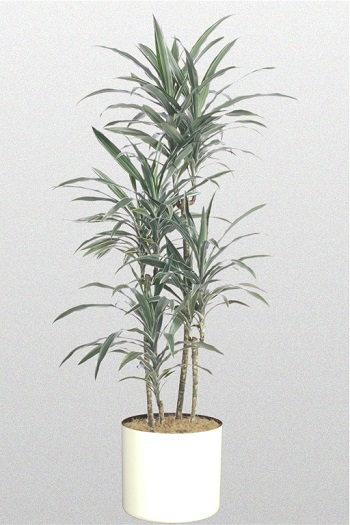Dracaenas are some of the most popular plants used in homes and offices today. They require little effort, thriving on low to medium light, very little humidity, and not much water. Dracaenas are stalk plants so be sure the stalks are firm and strong and that there are several in the pot before purchasing one. These exceptionally easy-care and attractive plants also clean the air of harmful toxins such as benzene, formaldehyde, and trichloroethylene.
Dracaena Care
Light
Dracaenas, especially the Janet Craig Lisa, can survive in low light if you are very careful with water, but they grow faster in medium light. If the light is extremely sparse, new leaves may be smaller and narrower than older ones and further apart. Placing Dracaenas in the direct sun even for a few minutes burns the leaves; too much bright indirect light may bleach the leaves.

Water
With Dracaenas, less is always better. Water a Dracaena well until the water comes out the bottom drip holes. Do not water again until the top 50% of the soil has dried out. The darker the area, the less often a Dracaena needs water. Fluoride and other chemicals in the water cause brown tips and yellow spots on the leaves. If there are chemicals, allow the water to sit out over night so the chemicals can dissipate or use distilled water. Never use water that has passed through a softener. When in doubt, do not water.
Fertilizer
Dracaenas do not require much plant food. Feed a Dracaena once or twice a month in the spring and summer with a basic well- balanced houseplant food at 1/2 the recommended strength. Never feed in the fall and winter. Too much fertilizer is worse than too little because excess food causes leaf tip burn.
Humidity
These plants adapt very well to household or office humidity whether it’s high or low.
Temperature
Dracaenas do not like temperatures below 55 degrees and do best in a consistently warm room. Cold winter drafts and blowing heaters damage the leaves.
Flowering
Dracaenas rarely produce flowers indoors. If a Janet Craig variety does develop a bloom, remove it quickly or the shape of the tree and leaf development may be adversely affected.
Pests
Mealy Bugs, Thrips, and Scale can be a problem. Spray the Green Solution, a mixture of half alcohol, half water, a tablespoon of mineral oil, and a few tablespoons of liquid biodegradable soap, and then carefully wipe the leaves. This will get rid of dust buildup as well as the pests.
Diseases
Leaf Spot, caused by a fungus living in the soil, is the main disease problem. Over- watering causes root rot. The best way to handle both problems is to allow the soil to dry out.
Pot Size
All varieties of Dracaena do best when kept root bound in smaller pots.
Soil
These plants need a loose soil that drains quickly. Many times, Dracaenas are purchased planted in lava rock. Although this helps to prevent over watering, 2/3’s of the lava rock should be replaced with potting soil when it is time to repot the plant.
Propagation
Stem tip cuttings from one of the main healthy trunks are the best method for propagating a Dracaena.
Fun Facts About Dracaenas
The Origin of This Plant’s Name Means “Female Dragon”
The name Dracaena comes from the Greek word drakaina, which means female dragon. The Dracaena contains a resin in the stem which was compared to dragons’ blood due to the red gum-like quality. For many centuries, this was used for dyes, medicine, and even toothpaste. However, modern uses are limited mostly to creating varnish and photo engraving.
Dracaena is Related to the Asparagus Family
Though the displayed traits may be very different from this favorite summertime veggie, they are indeed under the Family Asparagaceae. The Genus Dracaena is made up of about 40 different species, the most popular being “Song of India.”
Dracaena is Toxic to Cats and Dogs
This one may not be as fun as the other facts, but important nevertheless! If eaten, cats and dogs will experience vomiting, overproduction of saliva and lack of appetite. Cats may also have dilated pupils. Make sure you keep your fluffy friends in mind while choosing houseplants, and if you just can’t live without the Dracaena, please make sure you are educated and cautious!
Related Articles & Free Email Newsletter
Plant Profile – Plumerias Are A Beautiful and Fragrant Tree
Plant Profile – Red Abyssinian Banana are Beautiful But Not Edible



Comment here